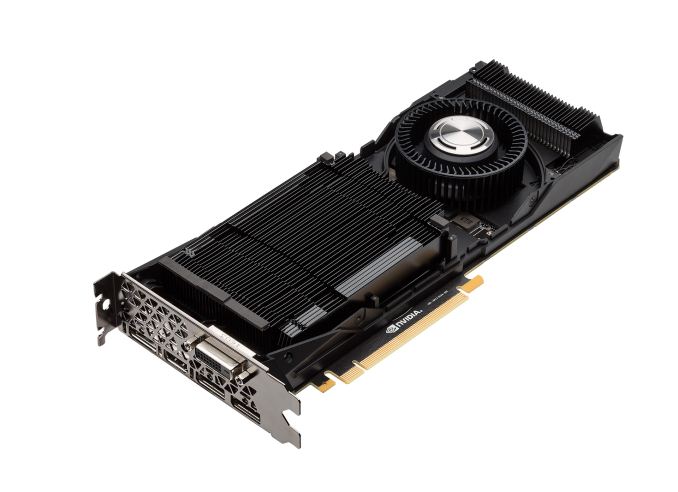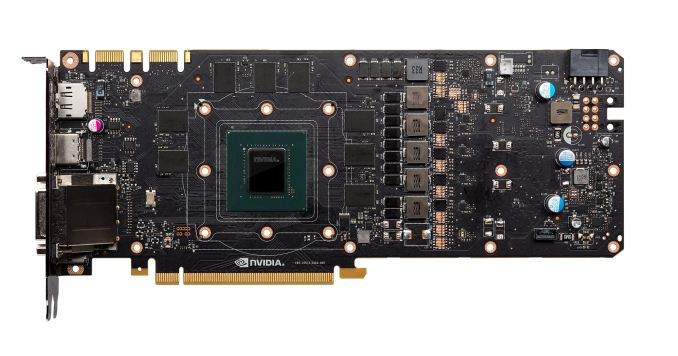The NVIDIA GeForce GTX 1070 Ti Founders Edition Review: GP104 Comes in Threes
by Nate Oh on November 2, 2017 9:00 AM EST- Posted in
- GPUs
- GeForce
- NVIDIA
- Pascal
- GTX 1070 Ti
Meet the GeForce GTX 1070 Ti Founders Edition
For the GeForce GTX 1070 Ti Founders Edition, pinned at the official MSRP of $449, NVIDIA has essentially plopped the GTX 1070 Ti GPU into a GTX 1080 board. This makes a lot of sense considering that this late-cycle card has the same GPU and 180W TDP requirements of NVIDIA's GeForce GTX 1080. Doing so allows NVIDIA to drop in the new specification and go with minimal changes, and similarly, their partners can take their own GTX 1080 designs and quickly reconfigure them for the GTX 1070 Ti.
The end result of this decision is that the GTX 1070 Founders Edition has the same power delivery and cooling specificaitons as the GTX 1080. Which is to say that it retains the same vapor chamber + blower cooling design, and the same 5+1 dual-FET power design. Similarly, that means the GTX 1070 Ti also has the same 120% power limit, and so extending the TDP to 216W. Otherwise, the PCB is exactly the same as the GTX 1080.
It is notable that the GTX 1070 Ti Founders Edition gets the vapor chamber cooler, as the card does not carry a price premium like the other Founders Edition cards do; NVIDIA is not charging more than their partners here. As a high efficiency cooling solution, the vapor chamber works well with the GTX 1070 Ti's increased (relative to the GTX 1070's) 180W TDP and 120% power limit. And while the blower fan is not the quietest, the Founders Edition is able to boost well past its paper-specified clockspeeds.
As we weren't provided with the GTX 1070 Ti PCB photos, we are using the GTX 1080 PCB with GDDR5X modules as an example. As with previous NVIDIA reference PCBs, the 5 GPU power phase and 1 GDDR5 phase is fine for stock operation and mild overclocking, rather than catering to the needs of hardcore overclockers. While not a major point, the Founders Edition isn't really apt to be pushed as a real "overclocking" card; it will boost a little higher but the user experience won't be significantly affected.
Finally, given the identical-to-1080 board design, the rest of the specifications should not come as a surprise. The 10.5" card requires a single PCIe 8-pin power connector for additional power, which combined with the 75W of the PCIe slot, gives the complete card more than enough power for its 180W TDP. Meanwhile on the display side of matters, the GTX 1070 Ti has 3x DisplayPort 1.4, an HDMI 2.0b port, and 1 DL-DVI-D port. The GTX 1070 Ti does support SLI, like all Pascal cards from the GTX 1070 and up.












78 Comments
View All Comments
Destoya - Thursday, November 2, 2017 - link
I feel like you're ignoring cards like the 1050ti/1050 in order to better match your narrative. Both of those require no power connectors (75W TDP) and will reach 1080p60 easily for modern AAA games and 144 FPS on esports titles. Yes, both companies are making power hungry monster cards to satisfy high-end demand that get a lot of headlines, but the chip designs scale down incredibly well. Performance for low/mid-end systems has never been as good as it is now.The_Assimilator - Friday, November 3, 2017 - link
Yes yes, everybody should still be using teletype terminals and typewriters. Or even better, go back to scratching lines into cave walls with rocks, because that uses no power and creates no heat.Lord of the Bored - Friday, November 3, 2017 - link
Actually, it does create heat. Thermodynamics is a harsh mistress.catavalon21 - Thursday, January 10, 2019 - link
+1sonny73n - Friday, November 3, 2017 - link
Graphic and resolution mean the world to them because they have no life.theuglyman0war - Saturday, November 4, 2017 - link
I thought it was because God gave us two eyes that can see? ( the same reason I get my prescription glasses updated every year. Fidelity. )Is Lo Fi hip again?
Ranger1065 - Friday, November 3, 2017 - link
You should be removed ASAP dear Ciccio.TheJian - Thursday, November 2, 2017 - link
Bought mine at $499 (EVGA FTW2). Don't feel gouged at all. If it's gouging, they'd still be on the shelf. I'm guessing they'll be out of stock shortly. If they priced like you want, they'd have quarterly reports like AMD.. ROFL. That should not be the goal for NV, but rather to price as high as the market will accept...PERIOD. It is actually their JOB to do this.Sounds like you need to upgrade your job so you can afford better toys ;) AMD has lost $8B in the last 2 decades and looks like they only made money for a single quarter this time. They are predicting a down Q yet again (how can you have a bad xmas Q?) and just after all these launches. YOU ARE PRICING YOUR STUFF TOO LOW AMD!
bill.rookard - Thursday, November 2, 2017 - link
Well, that's not entirely accurate, AMD has had some nominally profitable quarters before this - not to the level of Intel for sure, but saying they've lost money every single quarter in the past 20 years is patently untrue. There were many times 'in the past two decades' when they were actually eating Intel's lunch, so enough of the hyperbole.Yes, they've not had an easy time since then, and have been in the dumps especially with their previous generation designs which, well, sucked. (caveat, the 8 core 8000 series actually did well on video encoding but that wasn't nearly enough)
As for pricing stuff too low? They HAVE to right now. Their issue is one of market share, and with their previous generation u-arch it couldn't remotely compete with Intel, and that pitiful share is the result. Now that they have a u-arch which is close to parity from power and performance, just wait to see what happens in the notebook space where the Intel IGP is pitifully bad compared to the Mobile Vega. Besides - the main 'desktop' space is, while not dying, it is without a doubt somewhat stagnant as most people have a laptop which is powerful enough to get stuff done, while being portable.
That is the larger market, and one that the Ryzen APU's will have a much better chance at picking up share in.
webdoctors - Thursday, November 2, 2017 - link
You;re right, there was I guess maybe 40% quarters were profitable last 10 years:https://ycharts.com/companies/AMD/eps